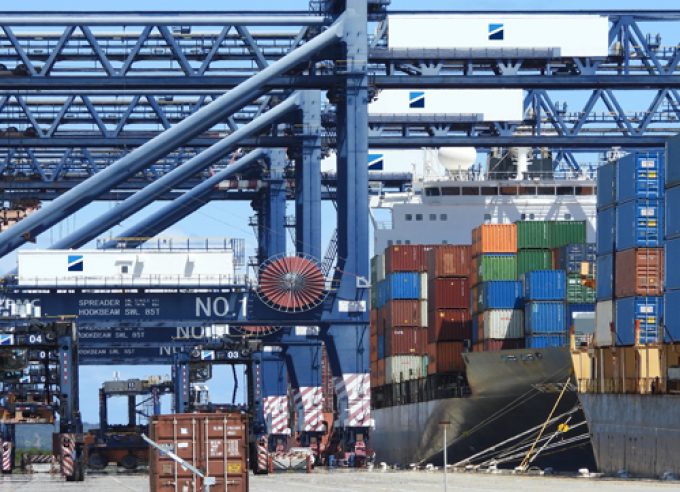Payday in Oz – time for higher transport rates
No profit here, please…
GM: RAISING THE ROOF GGM: IN FULL THROTTLE GZIM: MAERSK BOOST KNIN: READ-ACROSSMAERSK: NOT ENOUGHMAERSK: GUIDANCE UPGRADEZIM: ROLLERCOASTERCAT: HEAVY DUTYMAERSK: CATCHING UP PG: DESTOCKING PATTERNSPG: HEALTH CHECKWTC: THE FALLGXO: DEFENSIVE FWRD: RALLYING ON TAKEOVER TALKODFL: STEADY YIELDVW: NEW MODEL NEEDEDWTC: TAKING PROFIT
GM: RAISING THE ROOF GGM: IN FULL THROTTLE GZIM: MAERSK BOOST KNIN: READ-ACROSSMAERSK: NOT ENOUGHMAERSK: GUIDANCE UPGRADEZIM: ROLLERCOASTERCAT: HEAVY DUTYMAERSK: CATCHING UP PG: DESTOCKING PATTERNSPG: HEALTH CHECKWTC: THE FALLGXO: DEFENSIVE FWRD: RALLYING ON TAKEOVER TALKODFL: STEADY YIELDVW: NEW MODEL NEEDEDWTC: TAKING PROFIT

Hutchison Ports Australia (HPA) has issued 60-day Notices of Intention to increase its landside fee tariff and storage & handling charges at its container terminals in Sydney and Brisbane from 22 May.
Hutchison Ports proposes to:
• increase its Infrastructure Levy charged to all full import & export containers by just over 8% at both terminals (rising in Sydney to $173.03 and in Brisbane to $175.22 per full container)
• increase the cost of a container slot booking in the Truck Appointment System (TAS) for both terminals by between 12% and 14%, and stack run fees for full containers in Sydney by 6%
• increase truck no-show and slot listing fees by just over 7%, and side-loader fees by 6.94% in Sydney and 8.33% in Brisbane.
• introduce a new fee in Sydney of $40 per entry of a “double articulated vehicle (excluding B-doubles)”.
The Container Transport Alliance Australia (CTAA) said: “This new fee will penalise the use of higher-productivity freight vehicles (HPFVs) like Super B-doubles or A-double combinations from being serviced in Hutchison’s Sydney Terminal.”
The CTAA is a strong grouping of leading businesses engaged in Australia’s container transport logistics industry. CTAA companies account for the majority of containerised freight handled by the nation’s capital city ports.
It said: “HPA has given scant reasons for the fee increases, only citing broad details about terminal investments in landside equipment over the next three years, upgrades to terminal systems and’operational costs (which) have increased considerably more than forecasted, in particular fuel and power which has risen well above CPI’.”
And the alliance also opposes the Double-Articulated Vehicle Fee in Sydney. It said there was “no justification for the implementation of a new fee, which will penalise the use of HPFVs entering HPA’s Sydney Terminal”.
CTAA director Neil Chambers added: “We view this new fee as HPA simply following the lead of Patrick Terminals, which implemented a Long Vehicle Fee in 2021.
“HPA makes the broad statement that these vehicles take excessive time to position their trailers into truck grids, which has slowed productivity, and that the non-servicing of these vehicle types is three times higher than other vehicles. HPA has not shared any of that data with the container transport sector as a whole, and we question the data’s validity.
“A better metric would be container turn times at HPA’s terminals (ie, the number of containers loaded or unloaded from trucks in a given time), rather than focusing only on truck combination turn times … how does this measure of terminal productivity at HPA’s terminals compare with other container terminals in Australia?
“To meet future freight demands through Port Botany in a productive and sustainable way, the terminals and government should be encouraging the optimal use of transport assets to reduce the number of trucks required on the road to service the growing freight task.
“To revert to semi-trailer operations would simply increase the number of trucks exponentially and would be more harmful to the environment. So, to penalise HPFVs in this way is not good policy or practice … it’s just a revenue raiser.”
And the CTAA calls for better consultation on landside investments and productivity initiatives, saying: “Under the auspices of the National Voluntary Guidelines on stevedore landside charges, CTAA will be writing to Hutchison Ports Australia (HPA) seeking further details of how it intends to invest the revenue collected through landside charges and how those investments will benefit terminal productivity and efficiency.”
Comment on this article